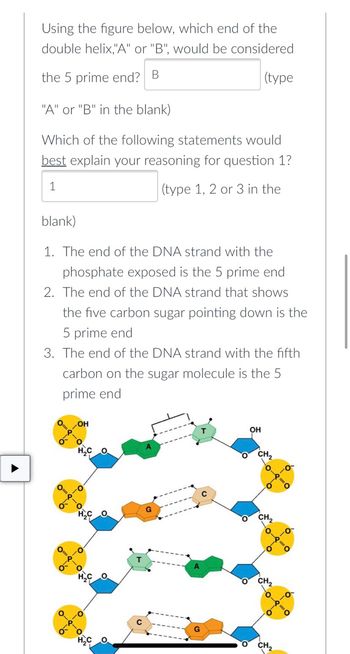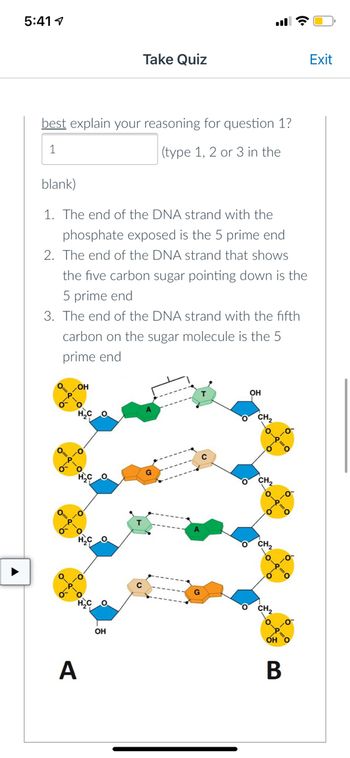
Human Anatomy & Physiology (11th Edition)
11th Edition
ISBN: 9780134580999
Author: Elaine N. Marieb, Katja N. Hoehn
Publisher: PEARSON
expand_more
expand_more
format_list_bulleted
Concept explainers
Question
Using the figure below, which end of the double helix,"A" or "B", would be considered the 5 prime end?
B
(type "A" or "B" in the blank)
Which of the following statements would best explain your reasoning for question 1?
1
(type 1, 2 or 3 in the blank)
The end of the DNA strand with the phosphate exposed is the 5 prime end
The end of the DNA strand that shows the five carbon sugar pointing down is the 5 prime end
The end of the DNA strand with the fifth carbon on the sugar molecule is the 5 prime end

Transcribed Image Text:Using the figure below, which end of the
double helix,"A" or "B", would be considered
the 5 prime end? B
(type
"A" or "B" in the blank)
Which of the following statements would
best explain your reasoning for question 1?
1
(type 1, 2 or 3 in the
blank)
1. The end of the DNA strand with the
phosphate exposed is the 5 prime end
2. The end of the DNA strand that shows
the five carbon sugar pointing down is the
5 prime end
3. The end of the DNA strand with the fifth
carbon on the sugar molecule is the 5
prime end
OH
OH
A
G
CH₂
OCH₂

Transcribed Image Text:5:41
Take Quiz
best explain your reasoning for question 1?
1
(type 1, 2 or 3 in the
blank)
1. The end of the DNA strand with the
phosphate exposed is the 5 prime end
2. The end of the DNA strand that shows
the five carbon sugar pointing down is the
5 prime end
3. The end of the DNA strand with the fifth
carbon on the sugar molecule is the 5
prime end
OH
OH
H₂
A
OH
G
OH O
B
Exit
Expert Solution
This question has been solved!
Explore an expertly crafted, step-by-step solution for a thorough understanding of key concepts.
Step by stepSolved in 2 steps with 1 images

Knowledge Booster
Learn more about
Need a deep-dive on the concept behind this application? Look no further. Learn more about this topic, biology and related others by exploring similar questions and additional content below.Similar questions
- If a double stranded DNA HAS 20 PERCENT OF CYTOSINE, calculate the percent of adenine of adenine in the DNA?arrow_forwardSarah is a scientist looking at specific sequences of base pairs on a DNA molecule within a specific cell. Which of the following pairings would she most likely observe in this DNA molecule? O Equivalent A and C base pairs O When she adds G and C base pairs together that would most likely equal the addition of A and T base pairs together O When she adds A and C base pairs together that would most likely equal the addition of G and T base pairs together O EquivalentA and G base pairs while C and Tsc pairs are equivalentarrow_forwardWhat role does bonding play in DNA? Where are hydrogen bonds located? Where are covalent bonds located? Why is that significant to the overall structure and function of DNAarrow_forward
- What is the DNA (template) strand of the following DNA (coding) strand: CAGGATGAATTGCTCarrow_forwardDNA structure depends on base pairing of its four nucleotides, A, C, T, and G. Nucleotide A pairs with T, and nucleotide C pairs with G. This forms a four-letter DNA “alphabet." Because DNA codes for amino acids in sets of three nucleotides, there are 4 cubed (4'), or 64, possible combinations, coding for 20 different amino acids. What is the best explanation for why there is no selective advantage for DNA to have five nucleotides (e.g., A, C, T, G, and E) with C pairing with either G or functionally equivalent E? It would be impossible to form the DNA molecule, because it must have an equal number of Cs and Gs. Because G and E have the same role, there would still be four functional letters of the alphabet. Replication would be inaccurate because sometimes C would bond with G and sometimes C would bond with E. There would be a five-letter alphabet with 125 combinations, which is too numerous. It is impossible because there are not five known nucleotides in the cell.arrow_forwardIf a DNA molecule is 22% adenine in any organism, which percentage of thymine will that DNA molecule contain? 22% 28% 44% 56% DNA contains a sugar. How many carbons does this sugar have? 6. 3 DNA contains a sugar. How many carbons does this sugar have? 6. 4. Which is the correct arrangement for a single DNAarrow_forward
- The rungs in the middle of the twisted ladder of a DNA are calledarrow_forwardWhat determines the sequence of nucleotides in the template strand of DNA? (The answer can be very basic don’t need lots of details)arrow_forwardA student has drawn an enlarged portion of a DNA “ladder” model to show two of the nucleotides in greater detail (in the same orientation as they would occur in the ladder model). Which two nucleotides did the student draw?arrow_forward
- Which of the following base pairs is/are not possible in B-DNA? H O A and B O A and C O only A O only B O Band C O only C O all of them O none of themarrow_forwardAssume that the molar percentage of thymine in a double stranded DNA is 20. What are the percentages of the four bases (G, C, T, A)? b. The base content of a sample of DNA is as follows: A=31% G=31% T=19% C=19%. What conclusion can be drawn from this information?arrow_forwardUsing the figure below, what is molecule "A" (type a 1, 2 or 3 in the blank) nuclease ligase DNA polymerase What is the function of molecule "A"? to separate the double helix into two to piece together the Okazaki segments to copy the new DNA strand to the old strand by complementary base pairing Using the figure below, what is molecule "G" (type a 1, 2 or 3 in the blank) nuclease ligase DNA polymerase What is the function of molecule "G"? to separate the double helix into two to piecearrow_forward
arrow_back_ios
SEE MORE QUESTIONS
arrow_forward_ios
Recommended textbooks for you
 Human Anatomy & Physiology (11th Edition)BiologyISBN:9780134580999Author:Elaine N. Marieb, Katja N. HoehnPublisher:PEARSON
Human Anatomy & Physiology (11th Edition)BiologyISBN:9780134580999Author:Elaine N. Marieb, Katja N. HoehnPublisher:PEARSON Biology 2eBiologyISBN:9781947172517Author:Matthew Douglas, Jung Choi, Mary Ann ClarkPublisher:OpenStax
Biology 2eBiologyISBN:9781947172517Author:Matthew Douglas, Jung Choi, Mary Ann ClarkPublisher:OpenStax Anatomy & PhysiologyBiologyISBN:9781259398629Author:McKinley, Michael P., O'loughlin, Valerie Dean, Bidle, Theresa StouterPublisher:Mcgraw Hill Education,
Anatomy & PhysiologyBiologyISBN:9781259398629Author:McKinley, Michael P., O'loughlin, Valerie Dean, Bidle, Theresa StouterPublisher:Mcgraw Hill Education, Molecular Biology of the Cell (Sixth Edition)BiologyISBN:9780815344322Author:Bruce Alberts, Alexander D. Johnson, Julian Lewis, David Morgan, Martin Raff, Keith Roberts, Peter WalterPublisher:W. W. Norton & Company
Molecular Biology of the Cell (Sixth Edition)BiologyISBN:9780815344322Author:Bruce Alberts, Alexander D. Johnson, Julian Lewis, David Morgan, Martin Raff, Keith Roberts, Peter WalterPublisher:W. W. Norton & Company Laboratory Manual For Human Anatomy & PhysiologyBiologyISBN:9781260159363Author:Martin, Terry R., Prentice-craver, CynthiaPublisher:McGraw-Hill Publishing Co.
Laboratory Manual For Human Anatomy & PhysiologyBiologyISBN:9781260159363Author:Martin, Terry R., Prentice-craver, CynthiaPublisher:McGraw-Hill Publishing Co. Inquiry Into Life (16th Edition)BiologyISBN:9781260231700Author:Sylvia S. Mader, Michael WindelspechtPublisher:McGraw Hill Education
Inquiry Into Life (16th Edition)BiologyISBN:9781260231700Author:Sylvia S. Mader, Michael WindelspechtPublisher:McGraw Hill Education

Human Anatomy & Physiology (11th Edition)
Biology
ISBN:9780134580999
Author:Elaine N. Marieb, Katja N. Hoehn
Publisher:PEARSON

Biology 2e
Biology
ISBN:9781947172517
Author:Matthew Douglas, Jung Choi, Mary Ann Clark
Publisher:OpenStax

Anatomy & Physiology
Biology
ISBN:9781259398629
Author:McKinley, Michael P., O'loughlin, Valerie Dean, Bidle, Theresa Stouter
Publisher:Mcgraw Hill Education,

Molecular Biology of the Cell (Sixth Edition)
Biology
ISBN:9780815344322
Author:Bruce Alberts, Alexander D. Johnson, Julian Lewis, David Morgan, Martin Raff, Keith Roberts, Peter Walter
Publisher:W. W. Norton & Company

Laboratory Manual For Human Anatomy & Physiology
Biology
ISBN:9781260159363
Author:Martin, Terry R., Prentice-craver, Cynthia
Publisher:McGraw-Hill Publishing Co.

Inquiry Into Life (16th Edition)
Biology
ISBN:9781260231700
Author:Sylvia S. Mader, Michael Windelspecht
Publisher:McGraw Hill Education